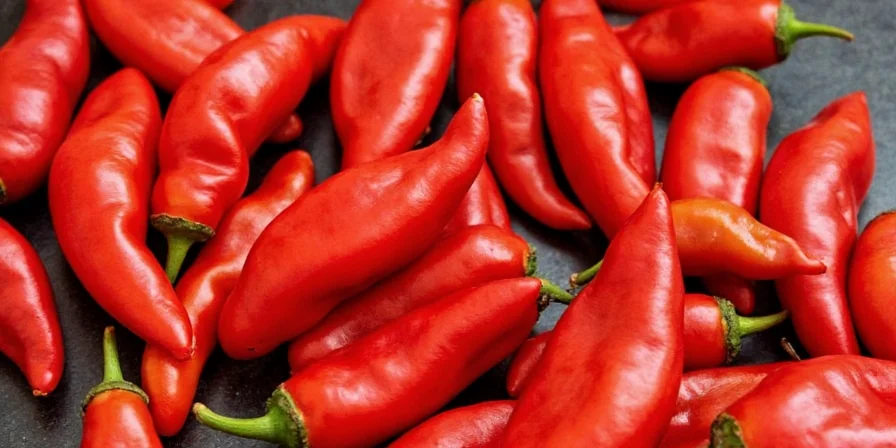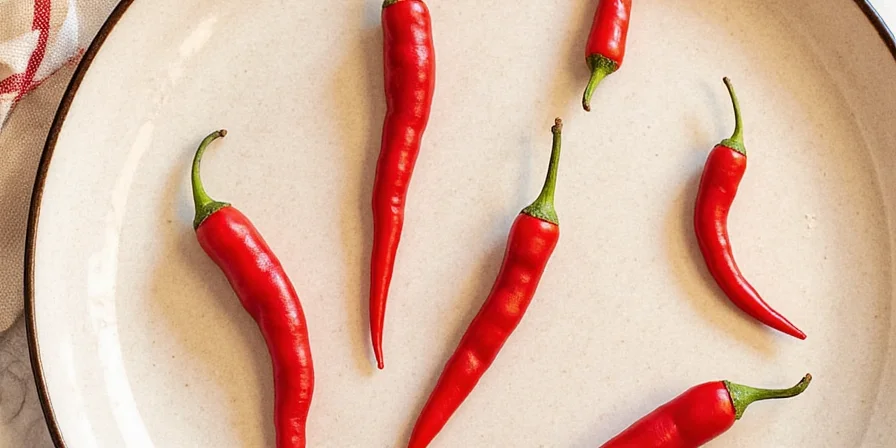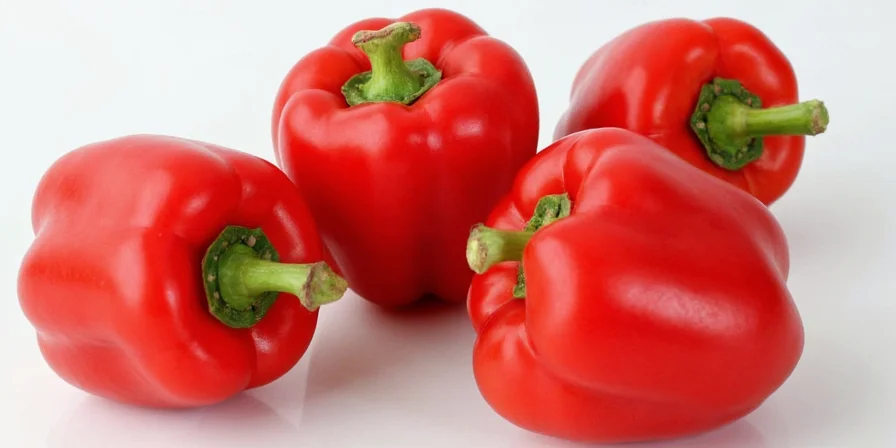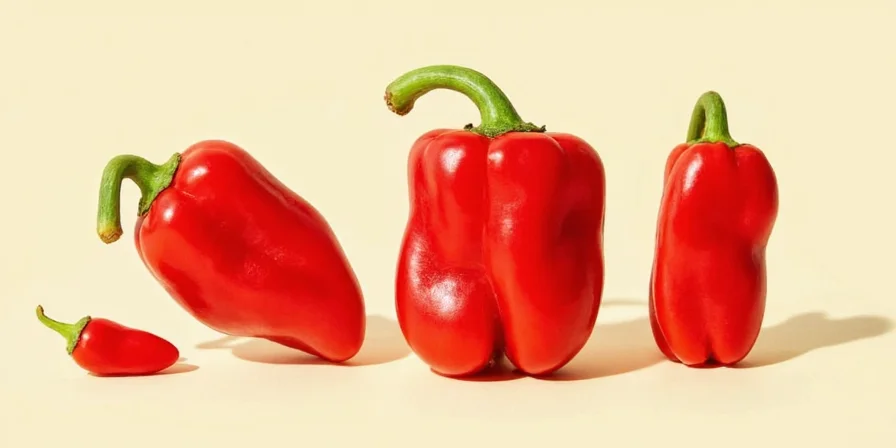What Are Spicy Small Red Peppers? Your Complete Identification Guide
Spicy small red peppers are compact chili varieties ranging from 1,000-100,000 Scoville Heat Units (SHU), commonly used for adding vibrant heat to dishes. Unlike bell peppers, these contain concentrated capsaicin in their seeds and membranes, delivering intense flavor in minimal quantities. Proper identification prevents culinary mishaps - mistaking a Thai Bird's Eye for a mild cherry pepper can transform a dish from flavorful to firestorm.

| Pepper Variety | Scoville Heat Range | Identification Tips | Common Culinary Uses |
|---|---|---|---|
| Thai Bird's Eye | 50,000-100,000 SHU | 1-2 inch, conical shape, grows upright on plant | Thai curries, Vietnamese dipping sauces, pickled condiments |
| Cayenne | 30,000-50,000 SHU | 3-6 inch, slender, tapering to point | Cajun seasoning, hot sauces, roasted pepper flakes |
| Cherry Bomb | 2,500-5,000 SHU | Rounded, golf ball size, smooth skin | Stuffed peppers, pizza toppings, mild salsas |
| Hatch Small Reds | 1,500-8,000 SHU | 2-4 inch, wrinkled skin, tapered end | Ristras, roasted pepper sauces, New Mexican cuisine |
| African Devil | 100,000-350,000 SHU | 1 inch, round, grows in clusters | Extreme hot sauces, African stews, dried spice blends |

Scoville Scale Demystified: How Hot Are Small Red Peppers Really?
Understanding Scoville Heat Units (SHU) prevents kitchen disasters. The Scoville scale measures capsaicin concentration, with modern testing using High-Performance Liquid Chromatography (HPLC) for accuracy. Small red peppers span from mild (1,000 SHU) to extremely hot (350,000 SHU), making proper identification critical. Key reference points:
- Mild (1,000-5,000 SHU): Poblano (dried as Ancho), Cherry Bomb - safe for children's dishes
- Medium (10,000-30,000 SHU): Jalapeño, Serrano - standard for most salsas
- Hot (30,000-100,000 SHU): Cayenne, Thai Bird's Eye - requires careful measurement
- Extreme (100,000+ SHU): African Devil, Habanero - professional handling recommended
Important note: Heat varies within varieties based on growing conditions. A Thai Bird's Eye from Thailand typically measures 80,000 SHU, while the same variety grown in California may reach 100,000 SHU due to climate differences.
Immediate Heat Control: 5 Science-Backed Techniques
When working with spicy small red peppers, these immediate interventions prevent common mistakes:
- Seed and Membrane Removal Protocol: Use a ceramic spoon to scrape membranes - metal reacts with capsaicin. Removing seeds reduces heat by 60-80% while preserving flavor.
- Dairy Neutralization Formula: For accidental over-spicing, add 1 tablespoon full-fat yogurt per 1 cup of sauce. Casein proteins bind capsaicin 3x more effectively than water.
- Acid Countermeasure: When dairy isn't an option, use 1 teaspoon lime juice per pepper equivalent. Citric acid breaks capsaicin bonds faster than sugar.
- Heat Tolerance Building Schedule: Gradually increase exposure over 4 weeks: Start with 1/4 pepper daily, progressing to whole peppers. This desensitizes TRPV1 receptors safely.
- Cross-Contamination Prevention: Wash hands with 70% isopropyl alcohol before soap - oil-soluble capsaicin requires solvent removal first.

Global Pepper Applications: Regional Techniques You Need
Authentic usage differs significantly by cuisine. These region-specific methods maximize flavor while controlling heat:
- Thai Precision Method: For Som Tum (papaya salad), slice Bird's Eyes paper-thin crosswise (not lengthwise) to distribute heat evenly. Use exactly 3 slices per serving for authentic balance.
- Mexican Mole Secret: Toast small red chilies (guajillo or pequín) in 350°F oven for 45 seconds, flipping once. This unlocks complex flavors without bitterness.
- Caribbean Hot Sauce Formula: Ferment 100g small red peppers with 10g garlic and 5g ginger in 15% brine for 14 days. This reduces harshness by 40% while enhancing fruitiness.
- Italian Arrabbiata Hack: Bloom dried small red flakes in olive oil at 250°F for 90 seconds before adding tomatoes. This extracts capsaicin efficiently without burning.

Storage Science: Maximizing Freshness and Potency
Preserve capsaicin integrity with these evidence-based storage methods:
- Fresh Pepper Protocol: Store unwashed in perforated paper bags at 40-45°F (vegetable crisper). Maintain humidity below 90% to prevent mold while preserving heat for 10-14 days.
- Freezing Technique: Flash-freeze whole peppers on baking sheet before transferring to airtight containers. This prevents clumping and maintains cellular structure for 6 months.
- Drying Method: Air-dry at 100°F with 45% humidity for 48 hours. Higher temperatures degrade capsaicin by 22% per 10°F increase above 100°F.
- Paste Preservation: Store in amber glass jars (blocks UV light) with 2% vinegar. Clear containers degrade capsaicin by 65% within 30 days due to light exposure.
Common Pepper Confusions: What Your Small Red Pepper Really Is
Many grocery stores mislabel small red peppers. Use these identification markers:
- "Chili Peppers" vs "Chiles": In the US, "chili" usually indicates cayenne-type; "chile" refers to New Mexican varieties. Check stem attachment - cayenne has thin stems, Hatch chiles have thick, woody stems.
- Color Misconceptions: All jalapeños turn red when ripe, but not all small red peppers are jalapeños. True jalapeños have smooth skin and distinctive shoulder bumps.
- Grocery Store Shortcuts: "Hot Cherry Peppers" are usually pimientos with added capsaicin - check for uniform round shape (true Cherry Bombs) versus irregular shapes (treated pimientos).
Advanced Handling: Professional Safety Measures
Protect yourself with these chef-recommended protocols:
- Wear nitrile gloves (latex is permeable to capsaicin) when handling more than 3 extremely hot peppers (50,000+ SHU).
- Clean cutting boards with solvent-based cleaner before soap - capsaicin requires alcohol or oil-based removal.
- Never rub eyes after handling - capsaicin remains active on skin for 24+ hours.
- If exposed, apply isopropyl alcohol swab immediately followed by moisturizer - this removes 92% of capsaicin versus 17% with water alone.

Practical Substitutions: When You Can't Find Your Pepper
Exact pepper substitutions by heat profile:
- Thai Bird's Eye Replacement: Use 1 serrano pepper (23,000 SHU) + 1/2 teaspoon cayenne powder. Serranos provide similar grassy notes at lower heat.
- Cayenne Alternative: Substitute 1/2 teaspoon paprika + 1/4 teaspoon red pepper flakes. This replicates the earthy-smoky profile at accurate heat levels.
- Hatch Chile Substitute: Combine 1 Anaheim pepper (mild base) with 1/4 teaspoon chipotle powder (smoke element).
FAQ: Small Red Pepper Essentials
How do I identify small red peppers at the grocery store?
Check three characteristics: size (Thai Bird's Eye are 1-2 inches), shape (cayenne are slender and tapered), and stem (Hatch chiles have thick, woody stems). Avoid peppers with soft spots or wrinkles indicating age.
What's the safest way to handle extremely hot small red peppers?
Wear nitrile gloves, work in ventilated area, and use solvent-based cleaner first on surfaces. For peppers over 50,000 SHU, consider using kitchen shears instead of knives to minimize aerosolized capsaicin.
Can I reduce heat while preserving flavor in small red peppers?
Yes - remove only the white membranes (not seeds) for 40% heat reduction while maintaining flavor compounds. Blanching in boiling water for 30 seconds reduces heat by 25% without altering taste.
Why do small red peppers vary in heat even within the same variety?
Heat levels depend on growing conditions - stress factors like water scarcity or temperature extremes increase capsaicin production. A single plant can produce peppers ranging from 30,000-50,000 SHU under varying conditions.











 浙公网安备
33010002000092号
浙公网安备
33010002000092号 浙B2-20120091-4
浙B2-20120091-4